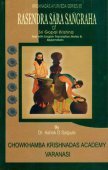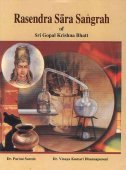Kankushtha, Kaṅkuṣṭha, Kamkushtha: 8 definitions
Introduction:
Kankushtha means something in Hinduism, Sanskrit, biology. If you want to know the exact meaning, history, etymology or English translation of this term then check out the descriptions on this page. Add your comment or reference to a book if you want to contribute to this summary article.
The Sanskrit term Kaṅkuṣṭha can be transliterated into English as Kankustha or Kankushtha, using the IAST transliteration scheme (?).
In Hinduism
Ayurveda (science of life)
Rasashastra (Alchemy and Herbo-Mineral preparations)
Source: Wisdom Library: Rasa-śāstraKaṅkuṣṭha (कङ्कुष्ठ):—One of the eight uparasa (‘secondary minerals’), a group of eight minerals, according to the Rasaprakāśasudhākara: a 13th century Sanskrit book on Indian alchemy, or, Rasaśāstra. It is a kind of medicinal earth produced from the mountains near the Himalaya range. It also known by the synonym Paluka.
There are two varieties of Kaṅkuṣṭha:
- Nalikā (yellow colored, superior variety)
- Reṇuka (blackish-yellow colored, inferior variety)
Kaṅkuṣṭha (rhubarb).—Beautifully shining Kaṅkuṣṭha is produced on the mountains which are very near to Himalaya.
It has two varieties on the basis of their form,
- Nalikā-kaṅkuṣṭha,
- Reṇuka-kaṅkuṣṭha.
In Gujarati it is called as Pīliyo which means it is yellow in colour.
There are a few scholars who consider Kaṅkuṣṭha as a fecal matter of newly born elephant child. It is blackish yellow in colour and highly purgative in action. There are other scholars who consider it as the nāla (ambilical cord) of baby horse. Out of these that which is produced from the elephant is either white or deep yellow in colour and that produces purgation quickly and this one is considered best for rasakarma and rasāyana-karma, it is associated with satva content and is heavy in weight.
It is tikta and kaṭu in Rasa, uṣṇa in Vīrya. Its specific action is rācana (purgative). The ancient scholars consider it better for destroying guda-śūla , gulma and vraṇaśūla.
If the poisonous effect of Kaṅkuṣṭha is seen i.e. purgation (loose motions) does not stop at its own, give babbūlamula-kvatha mixed with śuddha-taṅkaṇa and jīraka powder frequently (every half an hour) to check its bad/unwanted poisonous effect.

Āyurveda (आयुर्वेद, ayurveda) is a branch of Indian science dealing with medicine, herbalism, taxology, anatomy, surgery, alchemy and related topics. Traditional practice of Āyurveda in ancient India dates back to at least the first millenium BC. Literature is commonly written in Sanskrit using various poetic metres.
Biology (plants and animals)
Source: Google Books: CRC World Dictionary (Regional names)Kankushta in India is the name of a plant defined with Saussurea costus in various botanical sources. This page contains potential references in Ayurveda, modern medicine, and other folk traditions or local practices It has the synonym Aplotaxis lappa Decaisne (among others).
Example references for further research on medicinal uses or toxicity (see latin names for full list):
· Annals and Magazine of Natural History (1841)
· Repertorium Botanices Systematicae (1843)
· Botanicheskii Zhurnal (1964)
· Archives de Botanique (1833)
· Dict. Sci. Nat. (1827)
· Transactions of the Linnean Society of (1845)
If you are looking for specific details regarding Kankushta, for example chemical composition, diet and recipes, pregnancy safety, health benefits, side effects, extract dosage, have a look at these references.

This sections includes definitions from the five kingdoms of living things: Animals, Plants, Fungi, Protists and Monera. It will include both the official binomial nomenclature (scientific names usually in Latin) as well as regional spellings and variants.
Languages of India and abroad
Sanskrit dictionary
Source: DDSA: The practical Sanskrit-English dictionaryKaṅkuṣṭha (कङ्कुष्ठ).—A kind of medicinal earth (described as of two colours, one of a silvery and one of a gold colour, or one of a light and one of a dark yellow).
Derivable forms: kaṅkuṣṭhaḥ (कङ्कुष्ठः), kaṅkuṣṭham (कङ्कुष्ठम्).
See also (synonyms): kaṅguṣṭha.
Source: Cologne Digital Sanskrit Dictionaries: Monier-Williams Sanskrit-English DictionaryKaṅkuṣṭha (कङ्कुष्ठ):—m. a medicinal earth (described as of two colours, one of silvery and one of a gold colour, or one of a light and one of a dark yellow), [Suśruta]
[Sanskrit to German]
Sanskrit, also spelled संस्कृतम् (saṃskṛtam), is an ancient language of India commonly seen as the grandmother of the Indo-European language family (even English!). Closely allied with Prakrit and Pali, Sanskrit is more exhaustive in both grammar and terms and has the most extensive collection of literature in the world, greatly surpassing its sister-languages Greek and Latin.
Kannada-English dictionary
Source: Alar: Kannada-English corpusKaṃkuṣṭha (ಕಂಕುಷ್ಠ):—[noun] a kind of earth, believed to be medicinal, described to be of two colours silvery (or light yellow) and golden (or dark yellow).
Kannada is a Dravidian language (as opposed to the Indo-European language family) mainly spoken in the southwestern region of India.
See also (Relevant definitions)
Starts with: Kamkushthadighrita.
Ends with: Hemakamkushtha.
Full-text: Uparasa, Kankushta, Kalapalaka, Renuka, Viranga, Nalika, Sodhaka, Rangadayaka, Kalakushtha, Kankutthaka, Kangushtha, Balukakasisa, Pushpakasisa, Pulaka.
Relevant text
Search found 5 books and stories containing Kankushtha, Kaṅkuṣṭha, Kankustha, Kamkushtha, Kaṃkuṣṭha, Kankushta, Kaṅkuṣṭa, Kamkustha; (plurals include: Kankushthas, Kaṅkuṣṭhas, Kankusthas, Kamkushthas, Kaṃkuṣṭhas, Kankushtas, Kaṅkuṣṭas, Kamkusthas). You can also click to the full overview containing English textual excerpts. Below are direct links for the most relevant articles:
Rasa Jala Nidhi, vol 2: Minerals (uparasa) (by Bhudeb Mookerjee)
Part 2 - Purification of Kankustha (an ore containing tin) < [Chapter XV - Uparasa (16): Kankustha (an ore containing tin)]
Part 3 - How to take kankustha < [Chapter XV - Uparasa (16): Kankustha (an ore containing tin)]
Part 1 - Characteristics of Kankustha (an ore containing tin) < [Chapter XV - Uparasa (16): Kankustha (an ore containing tin)]
Rasa Jala Nidhi, vol 4: Iatrochemistry (by Bhudeb Mookerjee)
Treatment for fever (75): Mrita-sanjibana rasa < [Chapter II - Fever (jvara)]
Treatment for fever (76): Mrityu-nisudana rasa < [Chapter II - Fever (jvara)]
Atharvaveda and Charaka Samhita (by Laxmi Maji)
Rasendrasāra Saṅgraha (Āyurveda book) < [Chapter 1 - Introduction]
Rasa Jala Nidhi, vol 1: Initiation, Mercury and Laboratory (by Bhudeb Mookerjee)
Part 3 - Drawing of a hexagonal lotus diagram < [Chapter II - Initiation of Disciple]
Part 20 - Mercurial operations (18): Transformation of base metals into gold by mercury (bedhana) < [Chapter IV-V - Mercurial operations]
Part 19 - Mercurial operations (17): Dyeing of mercury (ranjana) < [Chapter IV-V - Mercurial operations]
Sushruta Samhita, volume 1: Sutrasthana (by Kaviraj Kunja Lal Bhishagratna)
Related products



